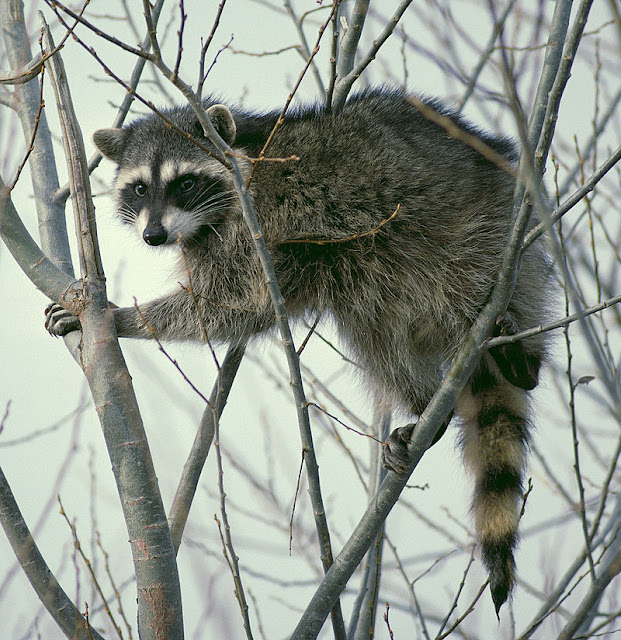Raccoon Facts
Raccoon Facts
Image Source:
"Raccoon climbing in tree - Cropped and color corrected" by Creator:Dave Menke -
http://commons.wikimedia.org/wiki/File:Raccoon_climbing_in_tree.jpg. Licensed
under Public Domain via Wikimedia Commons -
https://commons.wikimedia.org/wiki/File:Raccoon_climbing_in_tree_-
_Cropped_and_color_corrected.jpg#/media/File:Raccoon_climbing_in_tree_-
_Cropped_and_color_corrected.jpg
2. They are extremely adaptable thriving in a wide variety of habitat types including suburban neighborhoods. Raccoons are opportunistic feeders and will eat whatever is most abundant and readily available, including human discards, garbage or pet food.
3. The raccoon is one of the most easily recognizable furbearers; well known for its black face mask outlined in white and a bushy tail with alternating black and gray rings.
4. The front and hind paws of raccoons each have 5 digits. The very dexterous front paws are used to grasp and manipulate food items.
5. Raccoons can vary in weight from 12-36 pounds, with some exceptionally large raccoons reaching even heavier weights. They range in length from 23-38 inches including a 7-16 inch tail.
6. Raccoons are mostly crepuscular (active at dawn and dusk) and nocturnal (active at night), however they may be active during the day if food is available.
7. Raccoons are opportunistic feeders and will eat whatever is easiest to find and most readily available, however when food sources are most abundant, raccoons may be somewhat selective. They will eat plant material such as berries, nuts and seeds. They will also feed on crayfish, crabs, freshwater turtles and their eggs, injured waterfowl, muskrat kits, young birds and less frequently, bird eggs.
8. Den sites include hollow trees, groundhog dens, chimneys, garages, under the inside sheds, attics, porches and under decks.
9. Raccoons have amazing dexterity and use their front paws to pry things open, turn knobs and handle objects.
10. Except during breeding season or when with young, raccoons are territorial and usually solitary.
11. The animal’s vocalizations include purrs, whimpers, snarls, growls, hisses, screams, and whinnies.
12. Some raccoons like to “wash” their food (dunk it in water), and raccoons can often be found near water.
13. Raccoons don’t hibernate, but will spend really cold periods inactive in dens.
Image Source: "Raccoon (Procyon lotor) 2" by Darkone - Own work. Licensed under CC BY-SA 2.5 via
Wikimedia Commons - https://commons.wikimedia.org/wiki/File:Raccoon_
(Procyon_lotor)_2.jpg#/media/File:Raccoon_(Procyon_lotor)_2.jpg
15. Raccoons are excellent scavengers- they will raid garbage cans, dumpsters, pet food left out overnight, and even come into a house thru a pet door.
16. Remove a source of food and a raccoon will eventually leave for better food availability.
17. A raccoon will bite a pet if cornered or it feels threatened but prefers to run away from danger.
18. A raccoon might bite a human if: 1. it is rabid (intentional) or 2. If it has been handfed and is seeking a handout (accidental).
19. Raccoons can carry rabies and is one of the most common carriers of this disease.
20. Rabies in humans is extremely rare. The last known case of rabies in a human in Alabama was in 1994. Before that, it was in 1963.
21. You are millions of times more likely to be bitten by your pet dog, (3 million dog bites in the U.S. every year) than by any wildlife, including raccoons, coyotes, foxes, bears, cougars, etc,.
22. In a rural setting, there are approximately 5 raccoons per square mile. In urban settings, that number increases to 25 per square mile. The reason…available food.
23. The black markings on their faces make raccoons look like bandits and were a great source of mythology for the Native Americans.
24. In urban environments, raccoons are fond of “dumpster diving” and forage for food in trashcans.
25. Christopher Columbus is the first person known to have written about the raccoon.
26. Raccoons can run as fast as fifteen miles per hour and is one of the few mammals that can climb down a tree trunk headfirst.
27. Raccoons are very clean and use a common latrine in the wild.



Comments
Post a Comment